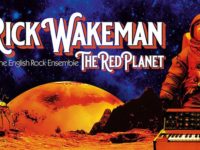If there is a central image of prog rock’s excesses, it is likely the cape-sporting Yes man Rick Wakeman surrounded by a semi-circle of towering keyboards.
But strip away at the pomp, the pageantry and, yeah, the cape, and there remains just as much musical brilliance, something you’re reminded of all over again with this never-before-released live date from 2003 with the New English Rock Ensemble. At times, In the Nick of Time has an almost unquenchable propulsion, as Wakeman works in furious bursts of creativity — moving from classically inspired fugues to gnarled rock squalls and back again, with all of these winkling squiggles of color in between.
There’s even a tasty deep-cut nugget for fans from his Yes years in the closing track “Wurm,” originally included as the final segment of “Starship Tooper” on 1970’s The Yes Album. It’s interesting not just because the track dates to before Wakeman’s tenure in the band, but also in that the Steve Howe composition doesn’t end up as a showcase for guitarist Ant Glynne (a veteran of tours and sessions with Asia, Mike Oldfield, Slash, Carl Palmer, Mavis Staples and Simon Phillips), so much as the young percussive bassist Lee Pomeroy — who performs with a thrumming power. Wakeman lets that unspool for awhile, before eventually powering his way to the fore with an expansive solo full of soaring runs.
[SOMETHING ELSE! REWIND: Long before Yes, Rick Wakeman was an ace studio musician. We examine his genius first-take contribution to David Bowie’s “Space Oddity.”]
In the Nick of Time opens with “Catherine Parr,” originally the finale on Wakeman’s 1973 solo release The Six Wives of Henry VIII, a complex and involving character analysis that finds Wakeman exploring both organ and synthesizer, before the track moves into a leaping, guitar-driven section powered by Glynne. Wakeman’s then-new album Out There provides both the title track and “Cathedral in the Sky.” The former becomes the first to showcase vocalist Ashley Holt — whose best-known work with Wakeman dates back to Six Wives and 1974’s Journey to the Centre of the Earth. (No Earthly Connection, 1976’s stripped-down set piece, also included both Holt and this date’s drummer Tony Fernandez, a sideman on Wakeman’s underrated 1985 release Silent Nights.)
These important assists from the New English Rock Ensemble, with whom Wakeman has been scheduling dates again for this summer, give In the Nick of Time a complexity that swerves well away from the baroque caricature: “Cathedral” includes a thunderous chorus, and a churchy organ turn from Wakeman to boot. Meanwhile, there is a diaphanous classical feel to “Dance of a Thousand Lights,” originally found on Wakeman’s 1999 concept album Return To The Centre Of The Earth. “White Rock,” the title song from a 1977 soundtrack, retains the original’s intricate amiability.
It’s not a perfect record. For instance, I have never found a way to like Holt — an often brittle, bombastic vocalist — as much as Wakeman so clearly does. That’s a small thing, however, on a project with so many sweeping delights. In the Nick of Time ends up as a tour de force reminder of the talent that always girded Rick Wakeman’s legend, with or without the cape.
[amazon_enhanced asin=”B0072X2NZI” container=”” container_class=”” price=”All” background_color=”FFFFFF” link_color=”000000″ text_color=”0000FF” /] [amazon_enhanced asin=”B000002GBJ” container=”” container_class=”” price=”All” background_color=”FFFFFF” link_color=”000000″ text_color=”0000FF” /] [amazon_enhanced asin=”B000002J1Y” container=”” container_class=”” price=”All” background_color=”FFFFFF” link_color=”000000″ text_color=”0000FF” /] [amazon_enhanced asin=”B000002GA8″ container=”” container_class=”” price=”All” background_color=”FFFFFF” link_color=”000000″ text_color=”0000FF” /] [amazon_enhanced asin=”B00000IL1O” container=”” container_class=”” price=”All” background_color=”FFFFFF” link_color=”000000″ text_color=”0000FF” /]
- The Band’s ‘Christmas Must Be Tonight’ Remains an Unjustly Overlooked Holiday Classic - December 25, 2016
- Nick DeRiso’s Best of 2015 (Rock + Pop): Death Cab for Cutie, Joe Jackson, Toto + Others - January 18, 2016
- Nick DeRiso’s Best of 2015 (Blues, Jazz + R&B): Boz Scaggs, Gavin Harrison, Alabama Shakes - January 10, 2016



